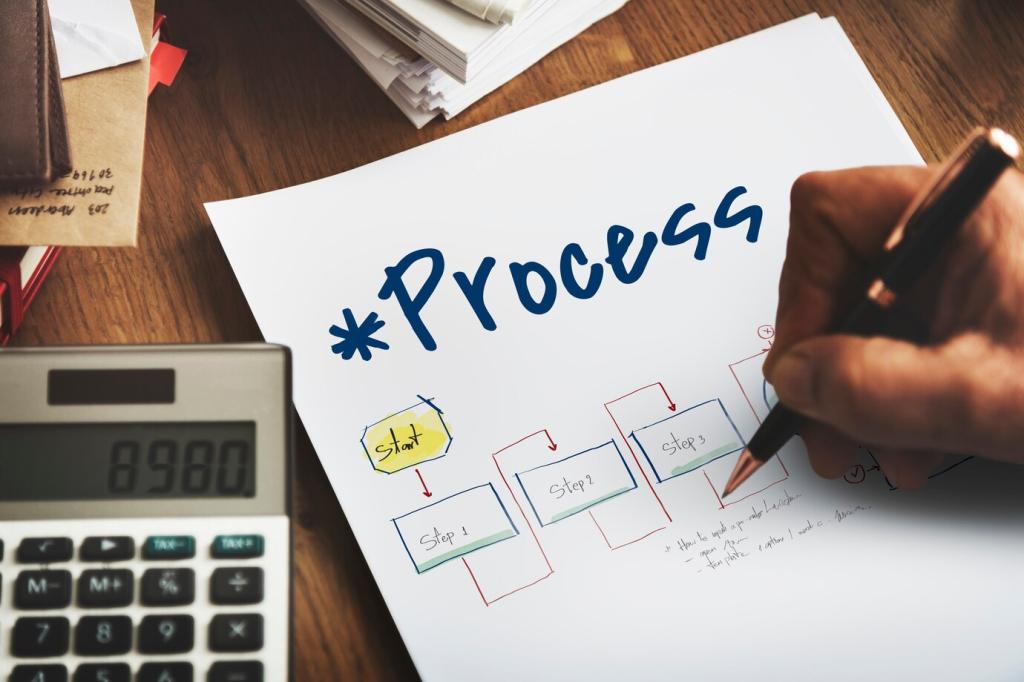Tools and Techniques for Process Mapping: Make Work Visible
Chosen theme: Tools and Techniques for Process Mapping. Explore practical methods, real stories, and proven tools to map processes clearly, engage your team, and spark meaningful improvements. Subscribe, comment, and share your mapping wins.



Choosing the Right Mapping Technique
Flowcharts are quick for discovery and training, while BPMN offers rigorous notation for complex, cross-functional processes. Start simple, validate understanding, then graduate to BPMN when precision, automation, or system integration demands it.
Choosing the Right Mapping Technique
SIPOC frames Suppliers, Inputs, Process, Outputs, and Customers in one page. It aligns expectations early, clarifies boundaries, and prevents scope creep before you dive into detailed maps. Share your favorite SIPOC tip in the comments today.
Gathering Reliable Process Data
Stakeholder Interviews with Evidence
Interview frontline staff and managers, then validate statements with tickets, emails, and system logs. Ask what actually happens on a busy day, not only what the handbook prescribes. Summarize insights back to participants to confirm accuracy.
Gemba Walks and Shadowing
Observing work where it happens surfaces invisible steps and handoffs. Note waiting times, tool switching, and interruptions. A short walk often reveals more than long meetings. Share an observation checklist your team finds helpful with our community.
Rapid Workshops with Brown Paper
Standing workshops around a long paper roll energize mapping. Participants add steps with sticky notes, cluster variations, and mark pain points. Timebox segments to maintain momentum, and capture photos to digitize afterward for ongoing refinement.
Digital Tools That Speed Up Mapping
Visio and Lucidchart offer templates, stencils, and collaboration that keep maps consistent. Set a shared library of symbols and colors, and document naming rules. Invite reviewers directly in-app to gather comments while context remains visible.
Digital Tools That Speed Up Mapping
Miro and Mural support messy discovery, voting, and clustering before you finalize details. Use frames to organize steps, and color-code issues versus ideas. Afterward, convert sticky clusters into structured swimlanes to preserve workshop intent.



Facilitation Techniques that Keep Sessions Productive
Assign a driver, scribe, and timekeeper. Set ground rules that focus on processes, not people. Encourage quiet contributors with structured turns and sticky-note rounds. Ask open questions, then reflect back what you heard to build shared understanding.
Facilitation Techniques that Keep Sessions Productive
Break mapping into short passes: outline, annotate, then enrich with data. Use a parking lot for off-topic debates, preserving momentum without losing ideas. Close each segment with clear next steps and owners to maintain accountability after sessions.
Finding Bottlenecks and Waste
Mark waiting, rework, motion, overprocessing, and handoff delays directly on the map. Quantify cycle time and queue lengths where possible. Prioritize constraints by impact and ease. Share one quick win you have achieved using this approach.
Handoffs, Roles, and RACI Clarity
Swimlanes reveal ownership gaps. Use RACI to clarify responsibilities for each step. When two teams own the same decision, define tie-breakers. Reducing ambiguous handoffs often improves speed and quality without additional technology investment.
Scenario-Based Redesign
Design the future state for common, urgent scenarios first. Replace approvals with thresholds, move checks upstream, and automate triggers. Pilot with a small cohort, gather metrics, and iterate. Invite peers to vote on your best redesign hypothesis.


Validation, Governance, and Living Documentation
Run step-by-step walkthroughs with real cases. Simulate edge conditions and failure points. Confirm data, systems, and roles match the diagram. Capture deviations, then update the map immediately so it remains a reliable reference for daily work.
Validation, Governance, and Living Documentation
Adopt version numbers and a naming convention that includes process, scope, and date. Centralize access with clear permissions. Archive old maps but keep them searchable. Encourage readers to share how their teams manage process map lifecycle.
The Problem Everyone Felt
A growing startup found new hires waiting days for system access. Managers blamed IT, IT blamed HR, and HR blamed incomplete forms. No one saw the full picture, so frustration simmered while productivity and morale visibly dipped.
The Mapping Moment
A one-hour brown-paper session exposed six approval loops and three duplicate checks. Switching to a BPMN draft, the team set thresholds and automated a trigger when paperwork was complete. Stakeholders finally shared a common, testable view.
The Result and Your Turn
Lead time fell from five days to twenty-four hours, measured for a month to confirm stability. The map now anchors onboarding reviews. Share a process you want to fix next, comment with your current toolset, and subscribe for deeper how-tos.

